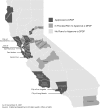Three years after legalization of nonprescription pharmacy syringe sales in California: where are we now?
- PMID: 20535641
- PMCID: PMC2900579
- DOI: 10.1007/s11524-010-9463-3
Three years after legalization of nonprescription pharmacy syringe sales in California: where are we now?
Abstract
In January 2005, passage of California Senate Bill 1159 enabled California's county or city governments to establish disease prevention demonstration projects (DPDPs) through which pharmacies could subsequently register to legally sell up to 10 syringes to adults without a prescription. California's 61 local health jurisdictions (LHJs) were surveyed annually in 2005-2007 to monitor the progress of DPDP implementation and assess program coverage, facilitators, and barriers. Completed surveys were returned by mail, fax, e-mail, phone, or internet. We analyzed 2007 survey data to describe current DPDP status; data from all years were analyzed for trends in approval and implementation status. By 2007, 17 (27.9%) LHJs approved DPDPs, of which 14 (82.4%) had registered 532 (17.8%) of the 2,987 pharmacies in these 14 LHJs. Although only three LHJs added DPDPs since 2006, the number of registered pharmacies increased 102% from 263 previously reported. Among the LHJs without approved DPDPs in 2007, one (2.3%) was in the approval process, seven (16.3%) planned to seek approval, and 35 (81.4%) reported no plans to seek approval. Of 35 LHJs not planning to seek approval, the top four reasons were: limited health department time (40%) or interest (34%), pharmacy disinterest (31%), and law enforcement opposition (26%). Among eight LHJs pursuing approval, the main barriers were "time management" (13%), educating stakeholders (13%), and enlisting pharmacy participation (13%). The17 LHJs with DPDP represent 52% of California's residents; they included 62% of persons living with HIV and 59% of IDU-related HIV cases, suggesting that many LHJs with significant numbers of HIV cases have approved DPDPs. Outcome studies are needed to determine whether SB 1159 had the desired impact on increasing syringe access and reducing blood-borne viral infection risk among California IDUs.
Figures
Similar articles
-
Increasing syringe access and HIV prevention in California: findings from a survey of local health jurisdiction key personnel.J Urban Health. 2007 Jan;84(1):116-25. doi: 10.1007/s11524-006-9122-x. J Urban Health. 2007. PMID: 17151941 Free PMC article.
-
Non-prescription syringe sales in California: a qualitative examination of practices among 12 local health jurisdictions.J Urban Health. 2010 Jul;87(4):561-75. doi: 10.1007/s11524-010-9445-5. J Urban Health. 2010. PMID: 20405227 Free PMC article.
-
Self-reported participation in voluntary nonprescription syringe sales in California's Central Valley.J Am Pharm Assoc (2003). 2017 Nov-Dec;57(6):677-685. doi: 10.1016/j.japh.2017.06.017. Epub 2017 Aug 12. J Am Pharm Assoc (2003). 2017. PMID: 28807658 Free PMC article.
-
Pharmacy nonprescription syringe distribution and HIV/AIDS: a review.J Am Pharm Assoc (2003). 2012;52(6):787-97. doi: 10.1331/JAPhA.2012.11136. J Am Pharm Assoc (2003). 2012. PMID: 23229966 Review.
-
Strategies to improve access to sterile syringes for injection drug users.AIDS Read. 2002 Dec;12(12):527-35. AIDS Read. 2002. PMID: 12518719 Review.
Cited by
-
Demographic, risk, and spatial factors associated with over-the-counter syringe purchase among injection drug users.Am J Epidemiol. 2012 Jul 1;176(1):14-23. doi: 10.1093/aje/kwr492. Epub 2012 May 4. Am J Epidemiol. 2012. PMID: 22562660 Free PMC article.
-
Nonprescription syringe sales: a missed opportunity for HIV prevention in California.J Am Pharm Assoc (2003). 2015 Jan-Feb;55(1):31-40. doi: 10.1331/JAPhA.2015.14148. J Am Pharm Assoc (2003). 2015. PMID: 25575149 Free PMC article.
-
Pharmacy syringe purchase test of nonprescription syringe sales in San Francisco and Los Angeles in 2010.J Urban Health. 2013 Apr;90(2):276-83. doi: 10.1007/s11524-012-9713-7. J Urban Health. 2013. PMID: 22718357 Free PMC article.
-
Access to sterile syringes through San Francisco pharmacies and the association with HIV risk behavior among injection drug users.J Urban Health. 2010 Jul;87(4):534-42. doi: 10.1007/s11524-010-9468-y. J Urban Health. 2010. PMID: 20526690 Free PMC article.
-
Evaluating a statewide pilot syringe access program for injection drug users through pharmacies in California.J Urban Health. 2010 Jul;87(4):531-3. doi: 10.1007/s11524-010-9485-x. J Urban Health. 2010. PMID: 20549567 Free PMC article. No abstract available.
References
-
- California Department of Public Health, Office of AIDS Fact Sheet; Injection drug users and their sex/needle-sharing partners, September 2007. Accessed on December 1, 2009. Available at: http://www.cdph.ca.gov/programs/aids/Documents/FS2527IDU2007-09-17.pdf.
-
- California Department of Public Health, Office of AIDS, HIV/AIDS Case Registry Section. California HIV Injection Drug Use Exposure Cumulative Cases as of January 31, 2008. Accessed on December 1, 2009. Available at: http://www.cdph.ca.gov/data/statistics/Documents/OA-2008-01HIVAIDSMerged....
-
- Armstrong GL, Wasley A, Simard EP, McQuillan GM, Kuhnert WL, Alter MJ. The prevalence of hepatitis C virus infection in the United States, 1999 through 2002. Ann Intern Med. 2006;144(10):705–714. - PubMed
Publication types
MeSH terms
LinkOut - more resources
Full Text Sources
Miscellaneous


